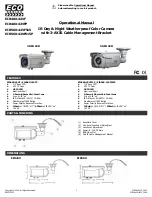
4-10
|
ni.com
Chapter 4
Connecting Lighting and External Devices
Connecting to Serial Devices
Use the RS232_RXD and RS232_TXD signals on the POWER-I/O connector for serial
communication. Connect the RS232_RXD signal on the NI Smart Camera to the Tx signal on
your serial device. Connect the RS232_TXD signal on the smart camera to the Rx signal on your
serial device. Connect COM on the smart camera to the ground of your serial device.
When the CONSOLE DIP switch is in the OFF position, you can use the NI-Serial driver for
serial communication. You must install the NI-Serial software on the smart camera; it is not
installed by default. Refer to the
Serial Hardware and Software Help
for information about
installing the NI-Serial software on LabVIEW Real-Time targets, such as the smart camera.
To open this document, navigate to
Start»All Programs» National Instruments»NI-Serial»
NI-Serial Help
.
Communicating with the Console
When the CONSOLE DIP switch is in the ON position, you can read device information from
the NI Smart Camera during startup, such as the IP address and firmware version, through a
serial port terminal program. Ensure that the serial port terminal program is configured to the
following settings:
•
9,600 bits per second
•
Eight data bits
•
No parity
•
One stop bit
•
No flow control
Connecting to a Quadrature Encoder
This section applies only to the following NI Smart Cameras:
•
NI 1732
•
NI 1752
•
NI 1754
Connect RS-422 compatible differential quadrature encoders to the NI 17xx Smart Camera to
provide positional information. A quadrature encoder uses two output channels, Phase A and
Phase B, to track the position of a rotary shaft. Generally, the shaft is coupled to a motor drive
that controls the movement of an object. By providing Phase A and Phase B signals to the smart
camera, you can obtain a precise measurement of the object position. Using a quadrature encoder
gives you the ability to specify your trigger delay in terms of positional units—such as inches or
centimeters, after applying the resolution information of your encoder—rather than time.
















































